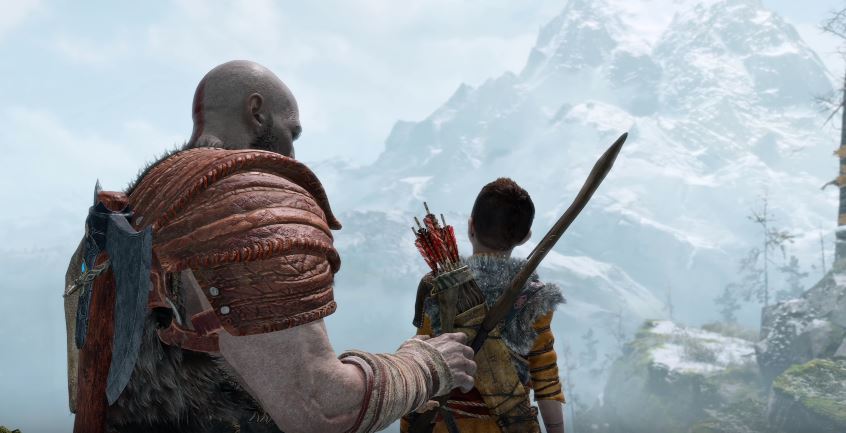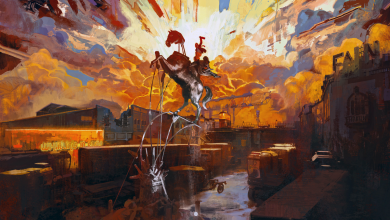Shifting Masculinities: How “God of War” Became “Dad of War”

Image via YouTube. / CC BY-NC 2.0
As far as video games go, “God of War” has never had a reputation as a franchise for being inclusive of or accessible to an audience beyond straight men who are deeply invested in their manliness. It has been a series steeped heavily in the tropes of hypermasculinity. Some people would arguably describe the games as enacting a male power fantasy with the extreme anger, violence, and hypersexualization of women featured in them. In doing this, the older games before the newest entry in 2018 catered only to a straight, male demographic and excluded everyone else.
The original main trilogy of games revolve around the male protagonist Kratos, a warrior of Sparta, who sets out to first destroy Ares, the god of war, and later other deities from Greek mythology out of anger and a desire for revenge against them. Kratos had previously served Ares as a weapon of war and destruction, but the god deceived him into killing his own wife Lysandra and daughter Calliope, spurring him on his quest to destroy Ares. This “fridging” (when a character, typically a woman, is hurt or killed in order to affect a male character’s development) of both women immediately frames these games in a masculinized light since they act as the motivation behind many of Kratos’ actions. It comes across as problematic as well because the blame is shouldered mostly on Ares and not Kratos, who made his family victims of his own brand of domestic abuse.
The newest game in the series, “God of War” (2018), has gone in a completely new direction from its predecessors and against its former tropes as a franchise. This entry continues to follow Kratos, but he has grown older and now lives in a realm ruled by Norse mythology. Before the game’s start, he married and had a child once again, this time a son named Atreus. During the introduction, the player learns that Kratos’ wife Faye has died and that Kratos and Atreus seek to fulfill her last wish of carrying her ashes to the highest peak in all the realms. Unlike Kratos’ former wife and child, Faye is not violently murdered at his hands, taking away this former troubling element from the original games. The game also does not serve as a narrative for vengeance any longer, but as a story focusing on fatherhood and healthier forms of masculinity. It goes against the other games’ stances on anger, violence, and female sexualization in ways that don’t necessarily rid itself of all of these problems but rather shapes them to more acceptable standards.
There is rarely a moment in the first three games when Kratos expresses an emotion beyond anger. It is, in fact, among his most defining features as a character. Even his special abilities in the first and second games are titled Rage of the Gods and Rage of the Titans. These feelings are never criticized in the games either but instead are encouraged. This highlights the stereotypical view that men are naturally angry and cannot express an emotion beyond that.
In the new game, on the other hand, Kratos acts much more calmly than before. He attempts to be a proper father figure and have moments of tenderness with his son, reaching out to Atreus several times in an act of bonding but shying away from the action. He sees anger as a weapon that can be utilized in combat but also something that must be maintained properly. He even criticizes Atreus early on when he allows his anger to get out of control, telling him he is not ready to become the warrior he desires to be. While still featured in the game and present in Kratos’ own character with such special abilities like Rage of Sparta, anger is no longer as glorified of an emotion as it once was.
Kratos’ rage in the original trilogy becomes even more apparent with the extreme violence he enacts in each game. While one can expect such a thing from a video game when facing enemies, Kratos also needlessly kills innocent Greek citizens who are trying to flee the destruction and monsters. There is even a section in the first game where Kratos must solve a puzzle by sacrificing a random soldier who is screaming desperately for him to stop. Furthermore, in order to gain items to use in his quest, Kratos often indulges in beating, killing, and mutilating other characters so that he can forcefully take what he needs from them.
In the first game, he kills and beheads Medusa in order to gain the power Medusa’s Gaze, which turns other enemies to stone. This violent act perpetuates the myth of Medusa, who was punished by Athena for being raped in her temple by Poseidon. Additionally, Kratos continuing to carry her head around as a weapon plays into the perception of women’s bodies as disposable. In the second game, the same happens with Medusa’s sister Euryale, who was also disturbingly punished in the myth for supporting Medusa after she was raped. Kratos violently rips the wings off of Icarus in the same game when he encounters him, gaining the ability to glide. In the third game, Kratos shifts his violence largely to the gods themselves, amputating Hermes’ feet in order to steal his boots and literally ripping Helios’ head from his body with his bare hands so that he can have the power of the sun. All of these examples demonstrate extreme, unnecessary levels of violence intended to showcase how unbelievably angry, strong, and masculine Kratos is as a character. The gamer wishing for this level of power fantasy thus receives the message that performing violence can be rewarding, empowering, and beneficial for themselves instead of damaging and harmful to others.
2018’s “God of War” still showcases many acts of violence, but none of it is projected onto innocent bystanders. It is focused purely on enemies and any gods who act in a hostile manner to Kratos and Atreus. Even when the previous plot device of taking body parts for tools comes up, it is portrayed in an extremely different way that is even strangely consensual rather than forceful. This occurs when Kratos and Atreus meet Mímir, another famous figure of Norse mythology, who explicitly requests them to cut off his head and then revive it so they can carry it around on their adventure. Unlike the other times, Kratos only takes from Mímir’s body when given permission to do so, erasing the problematic quality it could have held.
One other element in the original “God of War” trilogy that comes across as particularly egregious is the sex mini-games. At some point in each narrative, Kratos is given the option to have sex with topless women. When he enters the room, these women are usually engaging with each other sexually and delight at the sudden presence of a man who can finally fulfill their desires. They beg Kratos to bring them pleasure, proclaiming just how good he is in bed. These factors before the sex even starts play into a heterosexual male fantasy of being singled out as special, an “alpha male” and “sex god” among men. The actual mini-game involves the camera panning away from the explicit sex scene. The player pushes buttons or moves the controller’s joystick as the screen prompts them in order to ‘succeed’ in having sex with these women. The game rewards this behavior afterwards by giving Kratos red orbs that are used to upgrade his weapons and thus make him stronger in the process. In this way, the game equates sexual conquest with strength. Most notably, “God of War III,” aside from diverging by having Aphrodite as Kratos’ sexual partner, also shifts its camera to Aphrodite’s two handmaidens and have them react to the sex taking place offscreen. These two women become increasingly aroused at the sight and, if the player succeeds at the mini-game, they have sex with each other. All of these elements play into an extreme form of heterosexual masculinity where women exist only as physical objects waiting to be penetrated by men, and lesbian desire is fetishized and viewed as in response to erotic feelings for a man.
The newest game does not feature a sex mini-game, sex scene, or even nudity. It does not transform its female characters into objects to be sexualized or fetishized. Instead, Faye, while not actively present on screen, serves as a constant role model for Atreus after having more of an impact on him than Kratos did as a child. The Witch of the Woods acts a positive force for Kratos and Atreus during their journey, providing an example of a powerful and magical woman in the story. Women no longer exist in these games purely as passive sex objects or damsels but rather add to the narrative in a positive fashion.
None of this is to say that the “God of War” series has banished masculinity from its narrative. It still deals with the subject of anger. It still features large amounts of extreme violence. Women still serve as side characters and don’t receive as much attention as men do in the story. So I’m not claiming that “God of War” has completely stripped itself of what it originally was. But as times have changed, so has the series and Kratos along with it. Instead of being a one-note rage machine, Kratos’ character has become more multidimensional and complicated as an imperfect father figure who wants to improve. This is a much more interesting and appealing type of character to follow. While I enjoyed playing all the previous games, I can now play the new one and express my love of it with others without feeling like I am betraying my feminist ideals or I should be ashamed for recommending the series. If nothing else, the new “God of War” represents how one can tell a tale revolving around masculinity without being insulting or toxic in the process.




